#bangla lecture
Explore tagged Tumblr posts
Text
#বাংলা ওয়াজ#শায়খ আহমাদুল্লাহ#নতুন ওয়াজ#bangla lecture#islamic waz#islamic#hajj live 2022#tilawat quran#valobasar dua o amol#ayatul kursi#namaz#imam mahdi#bangla islamic waz#sheikh ahmadullah#শাইখ আহমাদুল্লাহ#waz#quran#roja#islam#salat#প্রশ্নোত্তর পর্ব#prosnottor#shaikh ahmadullah live#owaz#azan#hajj 2022#quran tilawat#আস সুন্নাহ ফাউন্ডেশন#নির্বাচিত প্রশ্নোত্তর#সাপ্তাহিক প্রশ্নোত্তর পর্ব
2 notes
·
View notes
Video
youtube
পদ্মা মেঘনা যমুনার তীরে | ইসলামী সংগীত | আল হেলাল ক্যাডেট মাদরাসা |pod...
#youtube#padma meghna jomunar tirepadma meghna jamunar tirepodma meghnanew gojol padma meghna jamunar tireei padma ei meghna ei jamunapodda megna jom#Introducing the latest addition to our collection of religious lectures the Bangla New Waz featuring renowned speakers Israfil Alom Helali a
0 notes
Text
Navigate the Seas of Opportunities: A Guide to Landing Your Dream Bangladesh Govt Job
For many Bangladeshis, securing a government job represents stability, prestige, and a fulfilling career path. With numerous positions across diverse fields, the Bangladesh government sector offers a vast ocean of opportunities for qualified individuals. But navigating this vast landscape can be daunting. Fear not, aspiring candidates! This comprehensive guide equips you with the knowledge and tools to chart your course towards your dream Bangladesh government job.
1. Dive into the Depths: Exploring Job Categories
The Bangladesh government encompasses a multitude of ministries, departments, and organizations, each with its unique job requirements. Familiarize yourself with the diverse categories:
Civil Service: Encompassing administrative, managerial, and professional roles across various ministries.
Defense Services: Including positions in the Army, Navy, Air Force, and Border Guard Bangladesh.
Education: From teachers and lecturers to administrators in universities and schools.
Healthcare: Doctors, nurses, paramedics, and other medical professionals serving public hospitals and clinics.
Technical Fields: Engineers, IT specialists, scientists, and technicians contributing to infrastructure development and research.
Public Sector Enterprises: Opportunities in banks, telecommunication companies, and other government-owned entities.
2. Chart Your Course: Eligibility and Qualifications
Each job category has specific eligibility criteria, usually outlined in official job circulars. Meticulously review these documents to ensure you meet the educational qualifications, experience requirements, and age restrictions. Remember, some positions require specific examinations, like the Bangladesh Civil Service (BCS) exams for administrative roles.
3. Stay on Course: Job Search Resources
Several valuable resources can guide your job search:
Bangladesh Public Service Commission (BPSC) Website: The official portal for government job notifications and application procedures.
Ministry Websites: Individual ministries often publish job openings on their websites.
Online Job Boards: Platforms like BDJOBS and Alljobs by Teletalk aggregate government job postings.
Newspapers and Magazines: Job circulars are frequently published in national and regional newspapers.
4. Navigate the Currents: Application Process
Once you identify a suitable position, carefully follow the application process outlined in the job circular. This typically involves:
Online Application: Most government jobs require online applications through designated portals.
Document Submission: Prepare and submit the required documents, including certificates, transcripts, and experience letters.
Examinations: Some positions involve written tests or competitive examinations.
Interview: Shortlisted candidates are usually called for interviews to assess their suitability.
5. Weather the Storms: Stay Updated and Persistent
The government job application process can be competitive and time-consuming. Stay updated on new job openings, diligently prepare for examinations, and don't be discouraged by setbacks. Persistence and a well-honed skillset are key to success.
Remember:
Stay informed: Regularly check job boards and relevant websites for new opportunities.
Network: Build connections with individuals working in your desired field.
Seek guidance: Consider professional guidance or coaching to enhance your application and interview skills.
With dedication, preparation, and the right resources, you can navigate the vast ocean of Bangladesh government jobs and land your dream position. So, set sail, equip yourself with knowledge, and chart your course towards a fulfilling career in the public sector!
0 notes
Video
youtube
Quran and Bible in the Light of Science Full Lecture Bangla। ডক্টর জাকির...
0 notes
Text
Us Bangla Medical College - Full Campus Visit

US-Bangla Medical College is one of the top colleges in Bangladesh. It was established in 2015 and is located in Tarabo, Rupgonj, Bangladesh. The college is affiliated with the University of Dhaka. It offers a 5 year Couse of MBBS to the aspirants. The college offers the MBBS course to foreign students also at an affordable price. When the student completes his/her graduation he/she can take training in the hospital. The language of instruction is English that makes it more comfortable for foreign students to study and communicate in the college. As compared to other countries MBBS in Bangladesh from US-Bangla Medical College is less expensive. The graduated students are eligible to get a job anywhere in the world because they are highly skilled and educated by the well-recognized college of Bangladesh.
Special features of USBMC:
The college is affiliated with The University of Dhaka.
The graduated students are eligible to get a job anywhere in the world because they are recognized.
There is a disciplined and peaceful atmosphere in the college.
Fully air-conditioned library is there with a vast collection of books.
The college contains adequate Lecture Galleries and well-equipped laboratories.
As compared to other countries MBBS in Bangladesh from USBMC is less expensive.
Followings are some facilities that are provide by US-Bangla Medical college to its students :-
Infrastructure and Campus
The academic building is equipped with an adequate number of lecture rooms, dissection halls, laboratories, and museums. The Internet facility is also provided in all the departments with access of facilities such as multimedia, audio-visual, scanners and others. The campus is connected with all the essential facilities such as ATM's, Railway Station and Airport in between the distance of about 5-10 kilometers that makes it easy for the students to avail these facilities.
Hospital
All the patients receive the same care and facilities at the hospital. The doctors and nurses working over there are highly dedicated and experienced. The techniques that are being used by the doctors of US-Bangla Medical College Hospital are ensuring the best services for many years. The hospital has equipped with the latest technology and equipment.
USBMC provides the following facilities :-
The hospital's OPD remains open for 365 days.
The cost of the hospital can be easily affordable.
The environment of the hospital is women and baby-friendly.
It have skilled teachers and staff and the students are trained by the doctors.
College Class Rooms
There are fully air-conditioned classrooms in the college and tutorial rooms attached with respective departments. Air-conditioned Anatomy Dissection Hall is also provided to the students. The college also provides different laboratories for various departments like Biochemistry and Pathology, etc.
College Library
The college library is furnished with air conditioners and a silent atmosphere. The library have an internet connection that makes students' studies more effective and interesting. For enriching the knowledge and developing the standard of learning the college has equipped a Central Library is the storehouse of information. They have computers for students’ use and faculty members.
College Hostel
The college hostel is very near to the college campus. The hostel is a well-furnished and secured place for the students as it is under the supervision of the superintendent of the hostel. There are two separate hostels in the college. One is for boys and the another is for girls.
College Canteen
A large canteen is also there in the college campus with delicious food. The canteen is fully furnished with modern furniture and utensils. The hygienic food is there and Indian food is also available. The priority is given to the cleanliness of the canteen that will help students to live healthy and happy life.
0 notes
Text

A digital marketing course
A digital marketing course
Money is rapidly being drained away from conventional marketing towards digital platforms, and, with that, the need for marketing professionals to get well-versed with digital techniques and analytical fundamentals has also increased.
What one will learn in Digital marketing course?
Search Engine Optimization (SEO): SEO is becoming a critical channel for marketing and helps in boosting your websites rank by fetching more traffic with keyword management, on- and off-page optimization, URL building, link building and many more of such facet. Students will be given a chance to do so on the Word Press site by using Yeast SEO plug-in.
Social media marketing: A social media campaigning strategy for a product or service is crafted and implemented on different platforms like Facebook and YouTube. Further, the success of the strategy amongst targeted audience is analyzed for conversion rate and amplification. It also gives an insight into how social media can play a critical role in brand building and if likes on social media really help in improving sales.
Web analytics: This part provides a chance to deal with real data in order to authenticate or confirm the hypotheses is real for any e-commerce store. Google analytics tool is quite handy and proved its value over time and, therefore, is the most used tool. Students can download the mobile application of Google Analytics for getting well- versed with the same.
Online advertisements: This gives an opportunity to get glibness in paid platforms on internet such as Google Ad Words, Facebook Ads and YouTube Ads to target the potential buyers, figure out the acquisition cost and campaigning costs. A spreadsheet is prepared to evaluate the profit margins and thoroughly compare the cost-per-click with average order price and customer lifetime value.
Data visualization: This segment deals with converting raw data into useful information for crafting dashboards to help the stakeholders remain updated with important figures and changes in them over time.
Opportunity to work with real e-commerce companies: Institutes invite designers, campaign strategists, and expert marketers to deliver special lectures on various topics like pros and cons of different marketing tools, email marketing, online network building, search engine optimization, user experience designing and mobile marketing etc. Students also get an opportunity to deal with these tools first hand by doing group as well as solo projects and building their personal website in Word Press. They are also made to work with e-commerce companies in real-time once they are well equipped with the knowledge of various facets of digital marketing.
Career prospects after the course
Students after clearing various exams conducted from time to time get a firm grasp on all tactics of digital marketing, various tools and resources that are available. They are also provided with quality placement assistance. It is one of the highest paid departments in any company. You have an option to work as a freelancer or get associated with companies and work in a more organized environment. Following are the posts available for marketing graduates with specialization in digital marketing:
Digital marketing manager
Content marketing manager
Social media marketing specialist
SEO executives
Copywriters
Content writers
Conversion rate optimizers
Search engine marketers
Inbound marketing experts
Marketing enthusiasts of Singapore now have an opportunity to become certified digital marketing strategists. Select a digital marketing course that suits your pace and interest and give new heights to your career. Amazing Tech Bangla is the best institute for digital marketing certification course in Singapore known for the highest placements in top companies across the world. Get the first-hand experience and learn efficiently through case studies, interaction sessions, engaging projects and class activities and after training assistance.
Visit here for more details: https://www.youtube.com/@AmazingTechBangla/videos
0 notes
Link
ছোট দুইটি মূলনীতি সারা জীবন মনে রাখুন
Shaikh Mujaffor Bin Mohsin
#Bangla Lecture#ছোট দুইটি মূলনীতি সারা জীবন মনে রাখুন#Education#Shaikh Mujaffor Bin Mohsin#দুইটি মূলনীতি
1 note
·
View note
Photo

Was bored in class. So took my atlas and drew this. Took me a week of not listening Chemistry and Bangla lectures. Hope you all like it. First post.
from /r/vexillology Top comment: You should be paying attention, but pretty picture
#Was#bored#class.#So#took#atlas#drew#this.#Took#week#listening#Chemistry#Bangla#lectures.#Hope#like#it.#First#post.#flags#vexillology
35 notes
·
View notes
Video
youtube
মালয়েশিয়া আজহারির সম্পূর্ন নতুন ওয়াজ 1✅ Mizanur Rahman Azhari✅ মিজানুর র...
#youtube#mizanur rahman azhari#waz#bangla waz#islamic video#islamic#islamic lecture#islam#light of islam
1 note
·
View note
Text
কেন সন্তান কথা শোনে না?
কেন সন্তান কথা শোনে না?
কেন সন্তান কথা শোনে না? সন্তান অবাধ্য এই অভিযোগ সব বাবা-মা’র কাছেই শোনা যায়। অবাধ্য ছেলে বা মেয়ের দৌরাত্ম্য নিয়ে আত্মীয় বা বন্ধু মহলে আলোচনা করা কম হয় না। কিন্তু একবার ভেবে দেখেছেন, কেন আপনার সন্তান কথা শোনে না ? শুধু কি কেবলই তার দোষ, না কি সেখানে আপনার ক্ষেত্রে কোন ফাঁক থেকে যাচ্ছে ? মায়ের অবাধ্য সন্তান মায়ের অবাধ্য সন্তান সন্তানকে উপযুক্ত করে লালন করার ক্ষেত্রে অনেক বাবা-মায়েরা ধারণা করেন…

View On WordPress
#sontan kotha mizanur_rahman_al-azhri#2020 waj#abdullah bin abdur razzak#abdullah waz#abdullahs waze#abdur razzak bin yousuf#abdur razzak bin yousuf waz#abdur razzak bin yousufs son lecture#ahb#ahb tv#ahbtv#ahbtvbd#amrita katha#bacchar jonno duadepression kibhabe bujhbo#bangla health tips#bangla new waz 2020#bangla short waz#bangla waz#bangla waz 2020#bangla waz short video#bd waz#best medical service#child and adolescent mental health disorders#child care#child development#child mental health definition#child mental illness symptom checker#child personality disorders#child psychology#childhood psychiatric disorders ppt
0 notes
Video
youtube
আমাদের জীবনের উদ্দেশ্য কি ? ডাঃ জাকির নায়েক | Dr. Zakir Naik Bangla Lecture
0 notes
Link
সবচেয়ে ভাগ্যবান কারা? |
Bangla Islamic Lecture on ‘Who are the luckiest’?
#Bangla Lecture#Bangla Lecture on Ikhlas#Islamic Bangla Lecture about Ikhlas#Bangla Lecture on ‘Who are the luckiest’?#Bangla Islamic Lecture on ‘Who are the luckiest’?#Shaikh Muzaffor Bin Muhsin
0 notes
Text
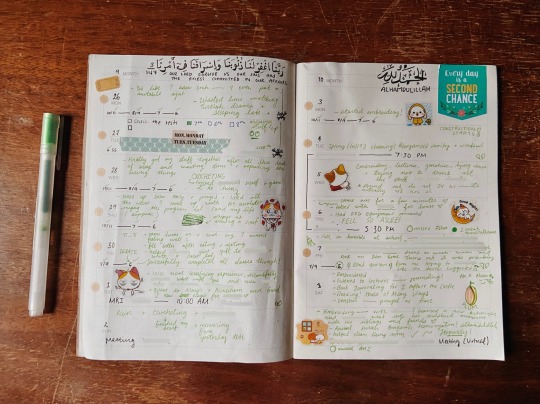
October 10, 2022 - Monday | Fall Studying Challenge 1/30
No class today because of Indigenous Peoples’ Day! I filled in some days I missed in my planner, finished my first embroidery project (for the most part), did some journaling, and found a new lecture series to listen to. I also ate some mint choco Milano cookies my beloved 🍪💓
Day 1: What is your major/What do you study?
In college I studied biology (she’s my bias), and also minored in political science… nowadays im teaching. In terms of my own studying, I love languages - Arabic, Spanish, Bangla, and Korean are the ones that I know and one of my dreams is to achieve fluency in all 5 languages 💕 I signed up for some arabic + islamic studies courses for next semester that start in the January so I’m excited for those! Esp since Arabic is my most neglected language fhdjdj I lost so much fluency in it I haven’t touched it since 2009 but hopefully this class helps!Oh! I also I love art so that’s also something I post abt and ‘study’ I suppose. As you can see tho I am an incoherent mess😌 there’s a reason my blog title is ‘try everything’ 😭
#studyingunderthefallingleaves#studyblr#studyspo#smh everytime I do a challenge my captions become so long#was abt to go into my life story abt each language but stopped myself#just wait till I add tranquils study challenge we r gonna have a swell time writing whole essays as captions 😭😅#my fatal flaw tho is refusing to speak any of these languages to natives because I’m Scared 😭😭🥲#natives meaning native speakers fhfhfh#except for one nice old lady who only knew spanish and wanted to converse with me I tried my best for her !#lowkey scared of Arabic grammar tho… I have war flashbacks to all the إعراب from 6th grade 🥲����#notes
22 notes
·
View notes
Text
finished revising the second lecture of 6.1B[bangla literature in translation] on history of modernist trends in bengali poetry. my semesters starts from 19th, had to put up with an all-nighter. i have 12 lectures more to revise. ☘️🏳️🌈
i'm taking up the summer study challenge started by @myhoneststudyblr , i'm really excited as to see where this goes. my assignments are due and i'll be completing them within today and tomorrow. i've never taken a study challenge and hence really looking forward to it. i hope i can attend every prompt each day. i'll urge others to take this challenge as well, as it's super productive and the questions are too nice. please go to the tagged blog and hop on the bandwagon! ❤️🌿
since it's 11th July, here's today’s prompt.
What is your favourite vacation memory?
a higher secondary vacation to a different district which gave me the opportunity to go away from my parents for at least 3 days.



#study aesthetic#study blog#study hard#studystudystudy#studyblr#study tips#study notes#study#study motivation#study space#studyvan#studygram#myhoneststudyblr#summer studying challenge#all nighter#productivity#positivity#motivation#assignment#handwriting#vintage#bengali literature in translation#revision#engblr#langblr#taking notes#lecture notes#notes#books#reading
28 notes
·
View notes
Text
16 December 1971 history of Bangladesh bangle.
youtube
Victory Day (বিজয় দিবস – Bijoy Dibos):
Is a national holiday in Bangladesh celebrated on December 16 to commemorate the victory of the Allied forces High Command over the Pakistani forces in the Bangladesh Liberation War in 1971. The Commanding officer of the Pakistani Forces General AAK Niazi surrendered his forces to the Allied forces commander Lt. Gen. Jagjit Singh Aurora, which marked ending the 9 month-long[1] Bangladesh Liberation War and 1971 Bangladesh genocide and officially secession of East Pakistan into Bangladesh.
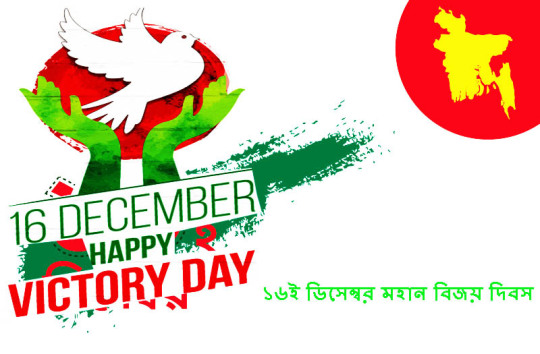
History:
The Bangladesh Liberation War (Bengali: মুক্তিযুদ্ধ Muktijuddho) was a South Asian war of independence in 1971 which established the sovereign nation of Bangladesh. The war pitted East Pakistan and India against West Pakistan, and lasted over a duration of nine months. It witnessed large-scale atrocities, the exodus of 10 million refugees and the displacement of 30 million people.

The war broke out on 26 March 1971, when the Pakistan Army launched a military operation called Operation Searchlight against Bengali civilians, students, intelligentsia and armed personnel, who were demanding that the Pakistani military junta accept the results of the 1970 first democratic elections of Pakistan, which were won by an eastern party, or to allow separation between East and West Pakistan. Bengali politicians and army officers announced the declaration of Bangladesh’s independence in response to Operation Searchlight. Bengali military, paramilitary and civilians formed the Mukti Bahini (Bengali: মুক্তি বাহিনী “Liberation Army”), which engaged in guerrilla warfare against Pakistani forces. The Pakistan Army, in collusion with religious extremist militias (the Razakars, Al-Badr and Al-Shams), engaged in the systematic genocide and atrocities of Bengali civilians, particularly nationalists, intellectuals, youth and religious minorities Neighboring India provided economic, military and diplomatic support to Bengali nationalists, and the Bangladesh government-in-exile was set up in Calcutta.

India entered the war on 3 December 1971, after Pakistan launched pre-emptive air strikes on northern India. Overwhelmed by two war fronts, Pakistani defenses soon collapsed. On 16 December, the Allied Forces of Bangladesh and India defeated Pakistan in the east. The subsequent surrender resulted in the largest number of prisoners-of-war since World War II.
Recognition of Bangladesh:
The Surrender of Pakistan Armed Forces marked the end of the Bangladesh Liberation War and the creation of Bangladesh (later reduced to a single word). Most United Nations member nations were quick to recognize Bangladesh within months of its independence.
Celebration:
The celebration of Victory Day has taken place since 1972. The Bangladesh Liberation War became a topic of great importance in cinema, literature, history lessons at school, the mass media, and the arts in Bangladesh. The ritual of the celebration gradually obtained a distinctive character with a number of similar elements: Military Parade by Bangladesh Armed Forces at the National Parade Ground, ceremonial meetings, speeches, lectures, receptions and fireworks. Victory Day in Bangladesh is a joyous celebration in which popular culture plays a great role. TV and radio stations broadcast special programs and patriotic songs. The main streets are decorated with national flags. Different political parties and socioeconomic organizations undertake programs to mark the day in a befitting manner, including the paying of respects at Jatiyo Smriti Soudho, the national memorial at Savar near Dhaka.
Background:

In August 1947, the Partition of British India gave birth to two new states; a secular state named India and an Islamic state named Pakistan. But Pakistan comprised two geographically and culturally separate areas to the east and the west of India. The western zone was popularly (and for a period of time, also officially) termed West Pakistan and the eastern zone (modern-day Bangladesh) was initially termed East Bengal and later, East Pakistan. Although the population of the two zones was close to equal, political power was concentrated in West Pakistan and it was widely perceived that East Pakistan was being exploited economically, leading to many grievances.

On 25 March 1971, rising political discontent and cultural nationalism in East Pakistan was met by brutal suppressive force from the ruling elite of the West Pakistan establishment in what came to be termed Operation Searchlight.
The violent crackdown by West Pakistan forces led to East Pakistan declaring its independence as the state of Bangladesh and to the start of civil war. The war led to a sea of refugees (estimated at the time to be about 10 million) flooding into the eastern provinces of India. Facing a mounting humanitarian and economic crisis, India started actively aiding and organizing the Bangladeshi resistance army known as the Mukti Bahini.
Political Differences:
Although East Pakistan accounted for a slight majority of the country’s population, political power remained firmly in the hands of West Pakistanis. Since a straightforward system of representation based on population would have concentrated political power in East Pakistan, the West Pakistani establishment came up with the “One Unit” scheme, where all of West Pakistan was considered one province. This was solely to counterbalance the East wing’s votes.

After the assassination of Liaquat Ali Khan, Pakistan’s first prime minister, in 1951, political power began to be devolved to the President of Pakistan, and eventually, the military. The nominal elected chief executive, the Prime Minister, was frequently sacked by the establishment, acting through the President.
East Pakistanis noticed that whenever one of them, such as Khawaja Nazimuddin, Muhammad Ali Bogra, or Huseyn Shaheed Suhrawardy was elected Prime Minister of Pakistan, he were swiftly deposed by the largely West Pakistani establishment. The military dictatorships of Ayub Khan (27 October 1958 – 25 March 1969) and Yahya Khan (25 March 1969 – 20 December 1971), both West Pakistanis, only heightened such feelings.
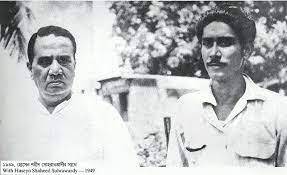
The situation reached a climax when in 1970 the Awami League, the largest East Pakistani political party, led by Sheikh Mujibur Rahman, won a landslide victory in the national elections. The party won 167 of the 169 seats allotted to East Pakistan, and thus a majority of the 313 seats in the National Assembly. This gave the Awami League the constitutional right to form a government. However, Zulfikar Ali Bhutto (a Sindhi), the leader of the Pakistan Peoples Party, refused to allow Rahman to become the Prime Minister of Pakistan. Instead, he proposed the idea of having two Prime Ministers, one for each wing. The proposal elicited outrage in the east wing, already chafing under the other constitutional innovation, the “one unit scheme”. Bhutto also refused to accept Rahman’s Six Points. On 3 March 1971, the two leaders of the two wings along with the President General Yahya Khan met in Dhaka to decide the fate of the country. Talks failed. Sheikh Mujibur Rahman called for a nationwide strike.
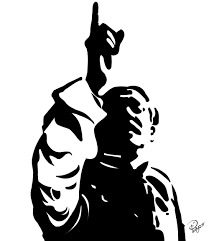
On 7 March 1971, Sheikh Mujibur Rahman (soon to be the prime minister) delivered a speech at the Racecourse Ground (now called the Suhrawardy Udyan). In this speech he mentioned a further four-point condition to consider the National Assembly Meeting on 25 March:
The immediate lifting of martial law.
Immediate withdrawal of all military personnel to their barracks.
An inquiry into the loss of life.
Immediate transfer of power to the elected representative of the people before the assembly meeting 25 March.
He urged “his people” to turn every house into a fort of resistance. He closed his speech saying, “Our struggle is for our freedom. Our struggle is for our independence.” This speech is considered the main event that inspired the nation to fight for its independence. General Tikka Khan was flown in to Dhaka to become Governor of East Bengal. East-Pakistani judges, including Justice Siddique, refused to swear him in.
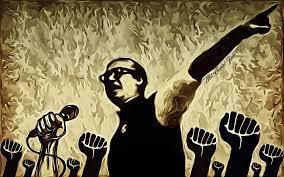
Between 10 and 13 March, Pakistan International Airlines cancelled all their international routes to urgently fly “Government Passengers” to Dhaka. These “Government Passengers” were almost all Pakistani soldiers in civilian dress. MV Swat, a ship of the Pakistani Navy, carrying ammunition and soldiers, was harbored in Chittagong Port and the Bengali workers and sailors at the port refused to unload the ship. A unit of East Pakistan Rifles refused to obey commands to fire on Bengali demonstrators, beginning a mutiny of Bengali soldiers.
Operation Searchlight:
A planned military pacification carried out by the Pakistan Army — code-named Operation Searchlight — started on 25 March to curb the Bengali nationalist movement by taking control of the major cities on 26 March, and then eliminating all opposition, political or military, within one month. Before the beginning of the operation, all foreign journalists were systematically deported from East Pakistan.

The main phase of Operation Searchlight ended with the fall of the last major town in Bengali hands in mid-May. The operation also began the 1971 Bangladesh atrocities. These systematic killings served only to enrage the Bengalis, which ultimately resulted in the secession of East Pakistan later in the same year. The international media and reference books in English have published casualty figures which vary greatly, from 5,000–35,000 in Dhaka, and 200,000–3,000,000 for Bangladesh as a whole.
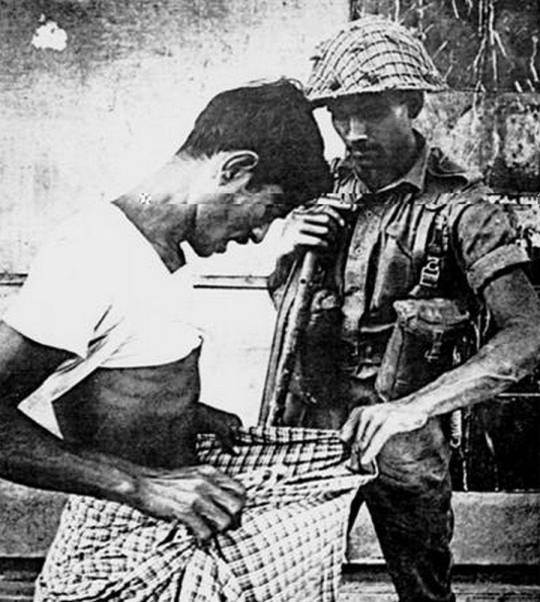
According to the Asia Times,
At a meeting of the military top brass, Yahya Khan declared: “Kill 3 million of them and the rest will eat out of our hands.” Accordingly, on the night of 25 March, the Pakistani Army launched Operation Searchlight to “crush” Bengali resistance in which Bengali members of military services were disarmed and killed, students and the intelligentsia systematically liquidated and able-bodied Bengali males just picked up and gunned down.
Although the violence focused on the provincial capital, Dhaka, it also affected all parts of East Pakistan. Residential halls of the University of Dhaka were particularly targeted. The only Hindu residential hall — the Jagannath Hall — was destroyed by the Pakistani armed forces, and an estimated 600 to 700 of its residents were murdered. The Pakistani army denies any cold blooded killings at the university, though the Hamood-ur-Rehman commission in Pakistan concluded that overwhelming force was used at the university. This fact and the massacre at Jagannath Hall and nearby student dormitories of Dhaka University are corroborated by a videotape secretly filmed by Prof. Nurul Ullah of the East Pakistan Engineering University, whose residence was directly opposite the student dormitories.

Hindu areas suffered particularly heavy blows. By midnight, Dhaka was burning, especially the Hindu dominated eastern part of the city. Time magazine reported on 2 August 1971, “The Hindus, who account for three-fourths of the refugees and a majority of the dead, have borne the brunt of the Pakistani military hatred.”
Sheikh Mujibur Rahman was arrested by the Pakistani Army. Yahya Khan appointed Brigadier (later General) Rahimuddin Khan to preside over a special tribunal prosecuting Mujib with multiple charges. The tribunal’s sentence was never made public, but Yahya caused the verdict to be held in abeyance in any case. Other Awami League leaders were arrested as well, while a few fled Dhaka to avoid arrest. The Awami League was banned by General Yahya Khan.

Atrocities:
During the war there were widespread killings and other atrocities – including the displacement of civilians in Bangladesh (East Pakistan at the time) and widespread violations of human rights – carried out by the Pakistan Army with support from political and religious militias, beginning with the start of Operation Searchlight on 25 March 1971. Bangladeshi authorities claim that three million people were killed, while the Hamoodur Rahman Commission, an official Pakistan Government investigation, put the figure as low as 26,000 civilian casualties. The international media and reference books in English have also published figures which vary greatly from 200,000 to 3,000,000 for Bangladesh as a whole. A further eight to ten million people fled the country to seek safety in India.
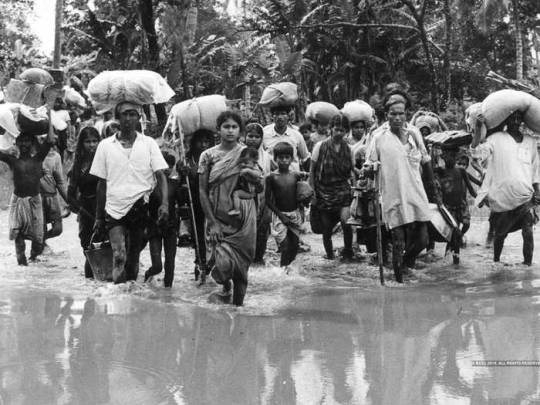
Large sections of the intellectual community of Bangladesh were murdered, mostly by the Al-Shams and Al-Badr forces, at the instruction of the Pakistani Army. Just 2 days before the surrender, on 14 December 1971, Pakistan Army and Razakar militia (local collaborators) picked up at least 100 physicians, professors, writers and engineers in Dhaka, and murdered them, leaving the dead bodies in a mass grave. There are many mass graves in Bangladesh, and as years pass, more are being discovered (such as one in an old well near a mosque in Dhaka, located in the non-Bengali region of the city, which was discovered in August 1999). The first night of war on Bengalis, which is documented in telegrams from the American Consulate in Dhaka to the United States State Department, saw indiscriminate killings of students of Dhaka University and other civilians. Numerous women were tortured, raped and killed during the war; the exact numbers are not known and are a subject of debate. Bangladeshi sources cite a figure of 200,000 women raped, giving birth to thousands of war babies. The Pakistan Army also kept numerous Bengali women as sex-slaves inside the Dhaka Cantonment. Most of the girls were captured from Dhaka University and private homes. There was significant sectarian violence not only perpetrated and encouraged by the Pakistani army, but also by Bengali nationalists against non-Bengali minorities, especially Biharis.
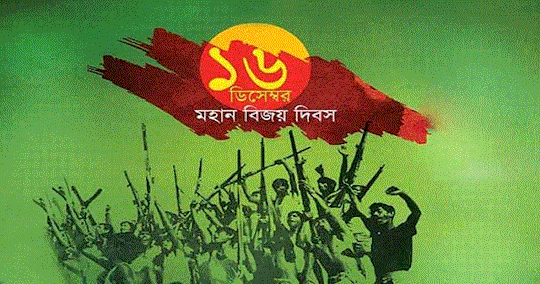
On 16 December 2002, the George Washington University’s National Security Archive published a collection of declassified documents, consisting mostly of communications between US embassy officials and United States Information Service centers in Dhaka and India, and officials in Washington DC. These documents show that US officials working in diplomatic institutions within Bangladesh used the terms selective genocide and genocide to describe events they had knowledge of at the time. Genocide is the term that is still used to describe the event in almost every major publication and newspaper in Bangladesh, although elsewhere, particularly in Pakistan, the actual death toll, motives, extent, and destructive impact of the actions of the Pakistani forces are disputed.
Liberation War:
March to June
At first resistance was spontaneous and disorganized, and was not expected to be prolonged.[45] But when the Pakistani Army cracked down upon the population, resistance grew. The Mukti Bahini became increasingly active. The Pakistani military sought to quell them, but increasing numbers of Bengali soldiers defected to the underground “Bangladesh army”. These Bengali units slowly merged into the Mukti Bahini and bolstered their weaponry with supplies from India. Pakistan responded by airlifting in two infantry divisions and reorganizing their forces. They also raised paramilitary forces of Razakars, Al-Badrs andAl-Shams (who were mostly members of the Muslim League, the then government party and other Islamist groups), as well as other Bengalis who opposed independence, and Bihari Muslims who had settled during the time of partition.
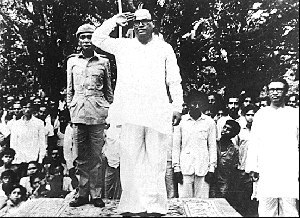
On 17 April 1971, a provisional government was formed in Meherpur district in western Bangladesh bordering India with Sheikh Mujibur Rahman, who was in prison in Pakistan, as President, Syed Nazrul Islam as Acting President, and Tajuddin Ahmed as Prime Minister. As fighting grew between the army and the Bengali Mukti Bahini an estimated 10 million Bengalis, mainly Hindus, sought refuge in the Indian states of Assam and West Bengal.
June – September
Bangladesh forces command was set up on 11 July, with Col. M A G Osmani as commander in chief, Lt. Col. Abdur Rab as chief of Army Staff and Group Captain A K Khandker as Deputy Chief of Army Staff and Chief of Air Force. Bangladesh was divided into Eleven Sectors each with a commander chosen from defected officers of the Pakistani army who joined the Mukti Bahini to conduct guerrilla operations and train fighters. Most of their training camps were situated near the border area and were operated with assistance from India. The 10th Sector was directly placed under a Commander in Chief (C-in-C) and included the Naval Commandos and C-in-C’s special force. Three brigades (11 Battalions) were raised for conventional warfare; a large guerrilla force (estimated at 100,000) was trained.
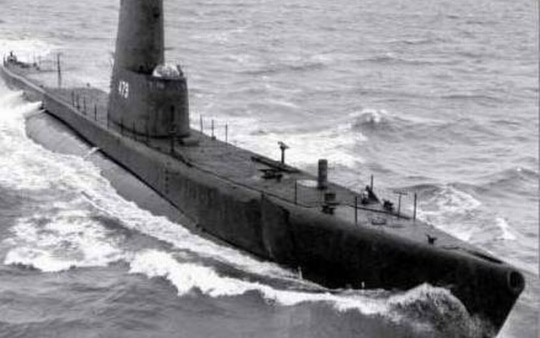
Guerrilla operations, which slackened during the training phase, picked up after August. Economic and military targets in Dhaka were attacked. The major success story was Operation Jackpot, in which naval commandos mined and blew up berthed ships in Chittagong on 16 August 1971. Pakistani reprisals claimed lives of thousands of civilians. The Indian army took over supplying the Mukti Bahini from the BSF. They organised six sectors for supplying the Bangladesh forces.
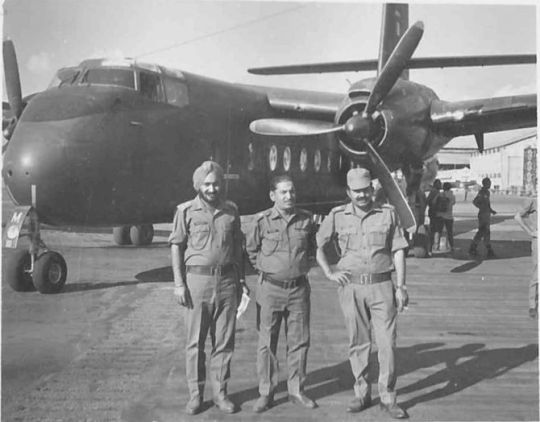
October – December
Bangladesh conventional forces attacked border outposts. Kamalpur, Belonia and Battle of Boyra are a few examples. 90 out of 370 BOPs fell to Bengali forces. Guerrilla attacks intensified, as did Pakistani and Razakar reprisals on civilian populations. Pakistani forces were reinforced by eight battalions from West Pakistan. The Bangladeshi independence fighters even managed to temporarily capture airstrips at Lalmonirhat and Shalutikar. Both of these were used for flying in supplies and arms from India. Pakistan sent 5 battalions from West Pakistan as reinforcements.
Declaration of Independence:
The violence unleashed by the Pakistani forces on 25 March 1971, proved the last straw to the efforts to negotiate a settlement. Following these outrages, Sheikh Mujibur Rahman signed an official declaration that read:
Today Bangladesh is a sovereign and independent country. On Thursday night, West Pakistani armed forces suddenly attacked the police barracks at Razarbagh and the EPR headquarters at Pilkhana in Dhaka. Many innocent and unarmed have been killed in Dhaka city and other places of Bangladesh. Violent clashes between E.P.R. and Police on the one hand and the armed forces of Pakistan on the other, are going on. The Bengalis are fighting the enemy with great courage for an independent Bangladesh. May Allah aid us in our fight for freedom. Joy Bangla.

Sheikh Mujib also called upon the people to resist the occupation forces through a radio message. Mujib was arrested on the night of 25–26 March 1971 at about 1:30 a.m. (as per Radio Pakistan’s news on 29 March 1971).

A telegram containing the text of Sheikh Mujibur Rahman’s declaration reached some students in Chittagong. The message was translated to Bangla by Dr. Manjula Anwar. The students failed to secure permission from higher authorities to broadcast the message from the nearby Agrabad Station of Radio Pakistan. They crossed Kalurghat Bridge into an area controlled by an East Bengal Regiment under Major Ziaur Rahman. Bengali soldiers guarded the station as engineers prepared for transmission. At 19:45 hrs on 27 March 1971, Major Ziaur Rahman broadcast the announcement of the declaration of independence on behalf of Sheikh Mujibur. On 28 March Major Ziaur Rahman made another announcement, which was as follows:
This is Shadhin Bangla Betar Kendro. I, Major Ziaur Rahman, at the direction of Bangobondhu Sheikh Mujibur Rahman, hereby declare that the independent People’s Republic of Bangladesh has been established. At his direction, I have taken command as the temporary Head of the Republic. In the name of Sheikh Mujibur Rahman, I call upon all Bengalis to rise against the attack by the West Pakistani Army. We shall fight to the last to free our Motherland. By the grace of Allah, victory is ours. Joy Bangla.

The Kalurghat Radio Station’s transmission capability was limited. The message was picked up by a Japanese ship in Bay of Bengal. It was then re-transmitted by Radio Australia and later by the British Broadcasting Corporation. M A Hannan, an Awami League leader from Chittagong, is said to have made the first announcement of the declaration of independence over the radio on 26 March 1971. There is controversy now as to when Major Zia gave his speech. BNP sources maintain that it was 26 March, and there was no message regarding declaration of independence from Mujibur Rahman. Pakistani sources, like Siddiq Salik in Witness to Surrender had written that he heard about Mujibor Rahman’s message on the Radio while Operation Searchlight was going on, and Maj. Gen. Hakeem A. Qureshi in his book The 1971 Indo-Pak War: A Soldier’s Narrative, gives the date of Zia’s speech as 27 March 1971.

26 March 1971 is considered the official Independence Day of Bangladesh, and the name Bangladesh was in effect henceforth. In July 1971, Indian Prime Minister Indira Gandhi openly referred to the former East Pakistan as Bangladesh. Some Pakistani and Indian officials continued to use the name “East Pakistan” until 16 December 1971.
Surrender & Aftermath:
On 16 December 1971, Lt. Gen A. A. K. Niazi, CO of Pakistan Army forces located in East Pakistan signed the instrument of surrender. At the time of surrender only a few countries had provided diplomatic recognition to the new nation. Over 90,000 Pakistani troops surrendered to the Indian forces making it the largest surrender since World War II. Bangladesh sought admission in the United Nations with most voting in its favor, but China vetoed this as Pakistan was its key ally. The United States, also a key ally of Pakistan, was one of the last nations to accord Bangladesh recognition. To ensure a smooth transition, in 1972 the Simla Agreement was signed between India and Pakistan. The treaty ensured that Pakistan recognized the independence of Bangladesh in exchange for the return of the Pakistani PoWs. India treated all the PoWs in strict accordance with the Geneva Convention, rule 1925. It released more than 90,000 Pakistani PoWs in five months.
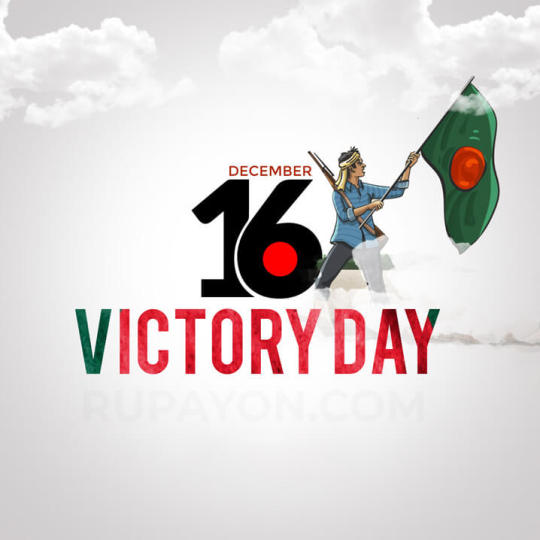
Further, as a gesture of goodwill, nearly 200 soldiers who were sought for war crimes by Bengalis were also pardoned by India. The accord also gave back more than 13,000 km² of land that Indian troops had seized in West Pakistan during the war, though India retained a few strategic areas; most notably Kargil (which would in turn again be the focal point for a war between the two nations in 1999). This was done as a measure of promoting “lasting peace” and was acknowledged by many observers as a sign of maturity by India. But some in India felt that the treaty had been too lenient to Bhutto, who had pleaded for leniency, arguing that the fragile democracy in Pakistan would crumble if the accord was perceived as being overly harsh by Pakistanis.
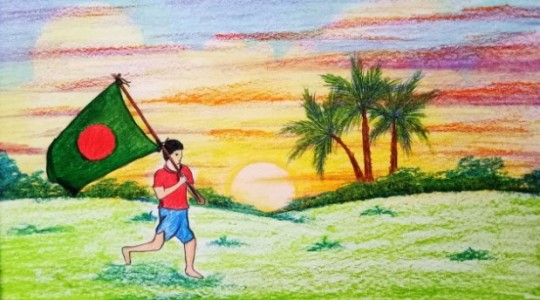
Thank you...
“Md. Masum Hossan”
10 notes
·
View notes
Link
Assalamu Alaikum True Message Viewers I hope you are well by the grace of Allah. You can know Sahih Bukhari / Muslim (Sahih Bukhari / Muslim Hadith), Islamic True Bangla History / Story, Islamic Lecture, Hadis Bangla, Waz Mahafil video, Islamic Gojol, Islamic Question Answer etc. through this True Message YouTube Channel. We know that we are the ummah of the last Prophet Muhammad (ﷺ) sent by Allah. Then no prophet will come to this world. That is why the Prophet Muhammad (ﷺ) has given us a great responsibility. Then we have to preach the message of Islam till the moment before the Resurrection of this world. The Prophet (ﷺ)also said, “Deliver even one verse from me” (Jame Tirmidhi). Also, the beloved Prophet Muhammad (ﷺ) said in the last sentence of his Farewell Hajj speech, "Let those who are present reach those who are absent" (Sirat Ibn Hisham) So, respect all listeners. If you want to be associated with our small efforts. Subscribe to our channel and share videos. Allah bless you.
#TrueMessage#TheTrueMessage#IslamicTrueMessage#ইসলামিক সত্য বার্তা#TrueMessageBangla#SahihMuslimHadith
1 note
·
View note